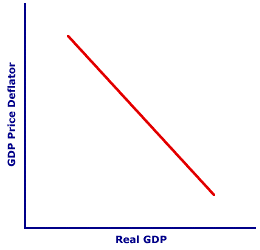
|
|
INFRASTRUCTURE: Capital used for transportation, communication, and energy delivery. This is often termed social overhead capital because it provides the basic capital foundation needed by an economy before business capital can adequately do its job.
Visit the GLOSS*arama
|
|


|

|
                           AGGREGATE DEMAND SHIFTS: Changes in the aggregate demand determinants cause the aggregate demand curve to shift. The mechanism is comparable to that for market demand determinants and market demand. There are two alternatives--an increase in aggregate demand and a decrease in aggregate demand. An increase in spending by any of the four sectors--household, business, government, and foreign--shifts the aggregate demand curve to right. A decrease in spending by these four sectors shifts the aggregate demand curve to left. | Shifting the Curve | 
|
To see how this works, consider the aggregate demand curve presented in the exhibit to the right. It is a standard negatively-sloped aggregate demand curve that captures the specific one-to-one relationship between the price level and aggregate expenditures. The assorted ceteris paribus factors, that is, the aggregate demand determinants, are assumed to remain constant with the construction of the curve.Analogous to other determinants, aggregate demand determinants shift the aggregate demand curve. A change in any of the determinants can either increase or decrease the aggregate demand curve. - An increase in aggregate demand is illustrated by a rightward shift in the aggregate demand curve. Click the [Increase in AD] button for a demonstration. What does it mean to have an increase in demand? It means that for every price level, the four sectors have an increase in aggregate expenditures on real production.
- A decrease in aggregate demand is illustrated by a leftward shift. Click the [Decrease in AD] button for a demonstration. What does it mean to have a decrease in demand? It means that for every price level, the four sectors have a decrease in aggregate expenditures on real production.
Shifts of the aggregate demand curve are often the source of disequilibrium in the aggregate market. Such disequilibrium then induces changes in the price level as the economy seeks to eliminate the disequilibrium. The key is that aggregate demand determinants CAUSE shifts of the aggregate demand curve which CAUSE disequilibrium which then CAUSES changes in the price level.This suggests an important difference between two related changes--a change in aggregate demand and a change in aggregate expenditures. - A change in aggregate demand is any shift of the aggregate demand curve. With this change, the entire curve shifts to a new location. A change in aggregate demand is caused by a change in the aggregate demand determinants. This is comparable to a change in demand in the analysis of the market.
- A change in aggregate expenditures is a movement along a given aggregate demand curve. This change involves the movement from one point on the existing curve to another point on the SAME curve. The curve does not move. A change in aggregate expenditures is caused by a change in the price level, and ONLY a change in the price level! This is comparable to a change in quantity demanded in the analysis of the market.

Recommended Citation:AGGREGATE DEMAND SHIFTS, AmosWEB Encyclonomic WEB*pedia, http://www.AmosWEB.com, AmosWEB LLC, 2000-2025. [Accessed: July 7, 2025].
Check Out These Related Terms... | | | | | | | | | | | |
Or For A Little Background... | | | | | | | | | | | | | |
And For Further Study... | | | | | | | | | | | |
Search Again?
Back to the WEB*pedia
|



|

|
GREEN LOGIGUIN
[What's This?]
Today, you are likely to spend a great deal of time going from convenience store to convenience store looking to buy either a birthday greeting card for your grandmother or a coffee cup commemorating yesterday. Be on the lookout for jovial bank tellers.
Your Complete Scope
This isn't me! What am I?
|

|
|
John Maynard Keynes was born the same year Karl Marx died.
|

|
|
"It is not because things are difficult that we do not dare; it is because we do not dare that they are difficult. " -- Seneca, statesman, dramatist, philosopher
|

|
SAIF
Savings Association Insurance Fund
|

|
|
Tell us what you think about AmosWEB. Like what you see? Have suggestions for improvements? Let us know. Click the User Feedback link.
User Feedback
|


|


